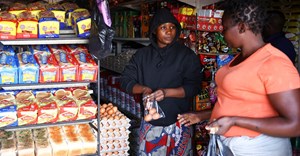Trending



 Clothing brand Curve Gear opens new store in Tygervalley CentreLindsey Schutters
Clothing brand Curve Gear opens new store in Tygervalley CentreLindsey Schutters Sabre EMEA 2024 Awards: Razor PR, Retroviral top SA agenciesDanette Breitenbach
Sabre EMEA 2024 Awards: Razor PR, Retroviral top SA agenciesDanette Breitenbach
Elections 2024
Jobs
- Social Media Content Creator West Rand
- Junior Social Media Manager Cape Town
- Social Media Copywriter and Paid Media Expert Johannesburg
- Customer Sales Consultant Nelspruit
- Content Creator Cape Town
- Social Media Manager Cape Town
- Marketing and Social Media Manager Cape Town
- Community Manager Cape Town
- Social Media/Digital Intern Cape Town
Social media: Promising arena for public debate

After all the government’s mandate is to educate and communicate information of public interest wide populations – young and old, all the times.
It is vital that the information that government communicating is compelling enough to convince young people to take part in public affairs. Therefore the communication strategy should be tailored in a manner that understands and engages young citizens.
Follow them where they are. And where they are is social media space
There are few prominent government communicators who are active on social media, however, often than not, those are active use social media for personal indulgence.
The trick is to use their followers on social media networks to galvanise patronage towards their respective ministries. The aim is to collaborate – for non-monitory purposes with governments to identify how social media can deliver to support their departments’ mission.
Through their communicators, the government ministries will leverage on the popularity of its communicators and reach more people on social media beyond just community media channel.
Population getting younger
The South African population is getting younger by age; two-thirds of the population is young people. According to the 2010 revision of the United Nations Secretariat’s World populations prospects, South Africa’s total population was 50,133,000 in 2010, 30.1% of the people were children under the age of 15, 65.2% were between 15 and 64 years of age, and 4.6% were older.
Statistics South Africa tells us that overall South Africa’s population is estimated at around 54,960,000 with a 1.51% increase in 2015. The painted picture here is that indeed South Africa’s population is younger than ever before. From that 55.21 million, 15 million are active social media users, not just passive users, however, those who actively spend most of their time on social media.
The above statistics say to government departments that they need to be responsive as a majority of social media users are active rather than passive. Therefore, consistently disseminating engaging and informative content. Engage don’t broadcast. The current status quo of government social media networks is just another form of notice boards.
In hindsight, all this presents opportunities for government communicators to adapt to the world of technology and innovation of which social media networks form an integral part. By harnessing the availability data about where and how your constituents are living. This will as well assist delivering services where are most needed.
Government failure to understand the target audience
The previous two elections both national and local, the government (political parties) has failed to persuade young people to vote. Yet again, an opportunity arises for the government and public service institutions – Independent Electoral Commissioner to persuade young people to register and vote.
The first step must be to re-examine the previous communication strategy. Therefore, the intelligence from the analysis of the previous communication and marketing strategy will aid inform the upcoming exercises for the 2019 general election.
By successfully understanding who their target is, where to find them, and what interests them shall assist communicators to tailor-made their message right to the right target audience. Of course, government services are for all constituencies. However, this cohort should a priority. Otherwise, the traditional community mobilisation shall continue on the ground.
‘Recently I was invited to a focus group discussion. The topic was 'understanding why young people don’t register to vote and obviously if not registered one won’t vote'. This particular study was targeting both female and male young people between the ages of 16 – 24 years. What I picked up is that most young people don’t know what the Independent Electoral Commission (IEC) is all about. Less than a handful know and understand its duties. The vast majority don’t understand IEC and its duties. And also fail to separate IEC from political parties.’
The above is a short version of how government and public services institutions are not marketing and communicating efficient and effective about their mandates.
Social media network and digital technology in government and public service institutions
The current practice reveals the extent to which departments spend time and resources on operations that could be simplified or even automated through the adoption of new technologies like coordinated social media marketing and as well as social media community management.
Social media networks present a major revolution in the way people interact and consume their news. It is now or never for the government to implement measure to digital transform their ministries. The transform could start from GCIS, Brand SA, and South African Broadcasting Commission, etc.
In order to communicate effectively with young people, using social media network, Facebook, Twitter, and Instagram should be prioritised. Because these platforms have grown exponential, and are predominately utilised by young people.
Government communicators need to keep up with the times and start communicating in a cost-effective manner through social media. There is no space for institutions that are operating in the Stone Age. Bureaucratic red tapes and government communication policies can still be amended in a direction that’s relevant to digital communication.
By getting this right, the government will see different results in the near future in terms of young people getting involved in their affairs. Social media can drive efficiency when it comes to the important governmental role of public outreach, such as encouraging young people to register for elections.
The traditional communication and advertising of putting the message out there and wait for the result is old school. Of progression, it is also vital that communicators know which platforms their targets use so that they can provide tailor-made marketing communication to those platforms. They also need to move their messages to where citizens want to engage: on social platforms.
Traditional media and new media
Traditional media still work to an extent. Radio, TV, and billboards cannot be ruled out. Distributing pamphlets and leaflets to young people is a waste of resources. The pamphlet will land into the next waste bin.
Rather design the same pamphlet but distribute it on Facebook or Twitter. Dissemination of information through these devices, one should avoid heavy content, simple yet effective is important to captivate the reader’s attention throughout.
Social media network is immediate – in real time – as events unfold. There’s no time for mistakes. One mistake, your department’s reputation is tarnished. Gone are the days of "any publicity is good publicity" particularly from government. So attention to detail is key.
Government and public service institutions must hire people with technical skills and crystal balls for social media and digital management to execute the duty.
I will leave this quote by Cory Booker, former mayor of Newark, New Jersey, US:
When we embraced social media, we took more control of the Newark narrative. We increased responsiveness towards residents. We drew more of our constituents in to participate in government and improve our cities.















